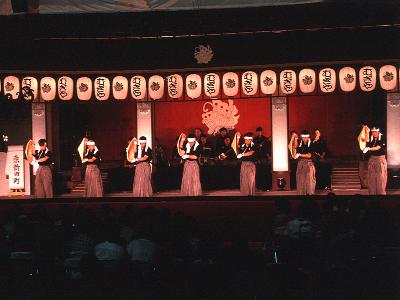|
Every year in the middle of September, a folk song event called Mugiyamatsuri (Mugiya Festival) takes place over two days in Nanto, Toyama Prefecture. The melody played during the festival is called 'mugiyafushi' and was composed by farmers working in fields of wheat ('mugi'). The melody emanates sadness and sorrow, but with the linear, brisk dancing, the result is a serene and meticulous collaboration of sound and movement.
About 800 years ago, the once-powerful Heike clan fell after their defeat at the battle of Dannoura. The Heike clan sought refuge in a secluded area called Echugokayama. The Heiki people became farmers, and sang the mugiyafushi as they harvested the land.
It is said that the 'mugiyafushi' originated from a song from Wajima on the Noto Peninsula, that was sung while making noodles. The merchants who sold noodles and wheat would travel from Noto to Echu, spreading songs such as the 'notomugiyafushi' and 'madara'. These songs eventually made their way to Gokayama, where they became known as the 'echumugiyafushi'.
Today, events such as performance competitions between citizens, as well as the 'mugiya odori' dance, take place on a special stage placed within the Johanabetsuin Zentokuji.
About 800 years ago, the once-powerful Heike clan fell after their defeat at the battle of Dannoura. The Heike clan sought refuge in a secluded area called Echugokayama. The Heiki people became farmers, and sang the mugiyafushi as they harvested the land.
It is said that the 'mugiyafushi' originated from a song from Wajima on the Noto Peninsula, that was sung while making noodles. The merchants who sold noodles and wheat would travel from Noto to Echu, spreading songs such as the 'notomugiyafushi' and 'madara'. These songs eventually made their way to Gokayama, where they became known as the 'echumugiyafushi'.
Today, events such as performance competitions between citizens, as well as the 'mugiya odori' dance, take place on a special stage placed within the Johanabetsuin Zentokuji.
| [+ADDRESS] | 
|











